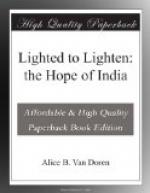The spending of the money is already planned. In the far north in a Punjabi village a house is now a building and its occupant is chosen. Miss Sirkar, a graduate now teaching in Kinnaird College, Lahore, has determined to leave her life within college walls, to move into the little house in the isolated village, and there on one third of her present salary to devote her trained abilities to the solution of rural problems. It is a new venture for an unmarried woman. It requires not only the gift of a dedicated life, but also the courage of an adventurous spirit. Elementary school teaching, social service, elementary medical help—these are some of the “jobs” that face this new missionary to her own people.
But, to return to Mrs. Appasamy, she not only organizes other people for work, but in the depressed communities of Madras herself carries on the tasks of social uplift. As supervisor of a Social Service organization, she has the charge of the work carried on in fifteen outcaste villages. With the aid of several co-workers frequent visits are made. Night schools are held for adults who must work during the hours of daylight, but who gather at night around the light of a smoky kerosene lantern to struggle with the intricacies of the Tamil alphabet. Ignorant women, naturally fearful of ulterior motives, are befriended, until trust takes the place of suspicion. The sick are induced to go to hospitals; learners are prepared for baptism; during epidemics the dead are buried. During the great strike in the cotton mills, financial aid was given. Hull House, Chicago, or a Madras Pariah Cheri—the stage setting shifts, but the fundamental problems of ignorance and poverty and disease are the same the world around. The same also is the spirit for service, whether it shines through the life of Jane Addams or of Mrs. Appasamy.
With the “Blue Triangle.”
The autumn of 1906 saw the advent of the first Indian student at Mt. Holyoke College. Those were the days when Oriental students were still rare and the entrance of Dora Maya Das among seven hundred American college girls was a sensation to them as well as an event to her.
It is a far cry from the wide-spreading plains of the Punjab with their burning heats of summer to the cosy greenness of the Connecticut valley—a far cry in more senses than geographical distance. Dora had grown up in a truly Indian home, as one of thirteen children, her father a new convert to Christianity, her mother a second generation Christian. The Maya Das family were in close contact with a little circle of American missionaries. An American child was Dora’s playmate and “intimate friend.” In the absence of any nearby school, an American woman was her teacher, who opened for her the door of English reading, that door that has led so many Oriental students into a large country. Later came the desire for college education. To an application to enter among the men students of Forman Christian College at Lahore came the principal’s reply that she might do so if she could persuade two other girls to join her. The two were sought for and found, and these three pioneers of women’s education in the Punjab entered classes which no woman had invaded before.




